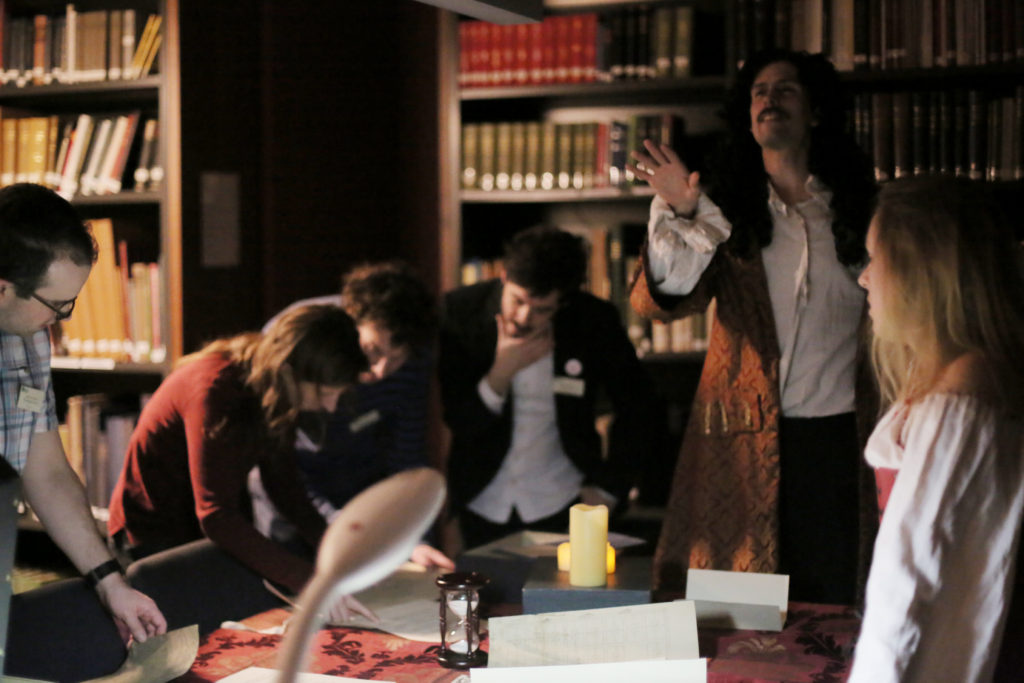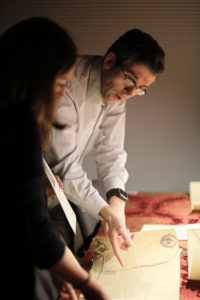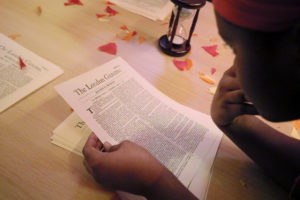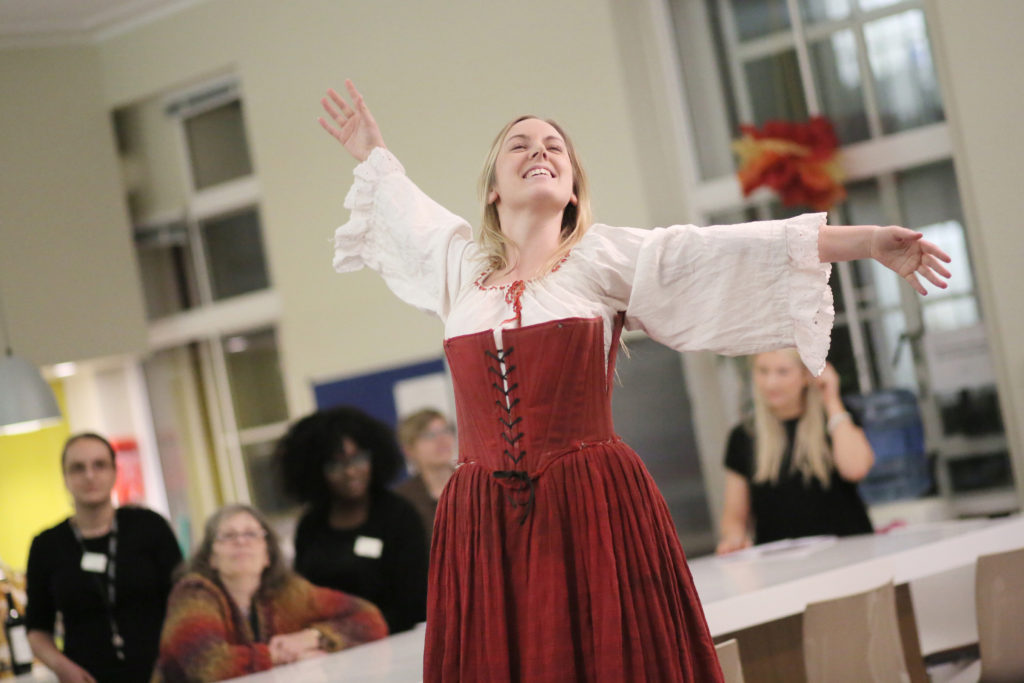
All images © Lloyd Sturdy
We would like to thank regular Friday night library readers for their induldgence over a few evenings in November. Regular visitors to the library may have noticed the odd room closed for mysterious purposes, spotted our Low Countries post-doctoral fellow poring over the typography of the London Gazette from 1666, or been bemused by members of This&That Productions looking for trapdoors and other hiding spots. All this preparation was in advance of ‘Night at the Library: books of hope and fear’, part of the IHR’s contribution to the 2016 Being Human festival of the humanities (you can also read about the IHR’s other event and exhibition, ‘Beside the Seaside’ here).
The festi val seeks to communicate the excitement of current humanities research, laced with the occasional dose of enjoyment. We wanted to do something in the library that explored the process of research, and perhaps introduced some new people to the richess and usefulness of the collection here. After thinking about some questions based around the collections, and making use of the library’s physical space, we very quickly realised that what we had in mind was a type of ‘Escape Room’, something that has rapidly become very popular since its origin in Japan in 2007 (and which can arguably be traced back to a series of popular TV shows in the 1980s and 90s). Ours involved a twist: we wanted to use a relatively new technology that uses small pucks to beam a geographically-specific message to a phone (or track participants around the room) via iBeacon or Eddystone protocols. Typically found at IT conferences, but also at a few cultural or heritage sites, such as Kew Gardens, it offered the chance to link the physical environment with digital resources. And with that, the ‘Book Sniffer’ was born (you probably had to be there.)
val seeks to communicate the excitement of current humanities research, laced with the occasional dose of enjoyment. We wanted to do something in the library that explored the process of research, and perhaps introduced some new people to the richess and usefulness of the collection here. After thinking about some questions based around the collections, and making use of the library’s physical space, we very quickly realised that what we had in mind was a type of ‘Escape Room’, something that has rapidly become very popular since its origin in Japan in 2007 (and which can arguably be traced back to a series of popular TV shows in the 1980s and 90s). Ours involved a twist: we wanted to use a relatively new technology that uses small pucks to beam a geographically-specific message to a phone (or track participants around the room) via iBeacon or Eddystone protocols. Typically found at IT conferences, but also at a few cultural or heritage sites, such as Kew Gardens, it offered the chance to link the physical environment with digital resources. And with that, the ‘Book Sniffer’ was born (you probably had to be there.)
We also needed a theme. Being Human’s exploration of hope and fear quickly suggested the Great Fire of London, not least because of the 350th anniversary year, but again to pin the event down in geographical terms: the w inners would be offered a night-time view of St Paul’s Cathedral from the top of the Senate House Tower. An application to Being Human was submitted, and we were fortunate enough to receive a grant, enabling us to secure the services of This&That Productions to help produce the event and develop scripts for four actors would posed the challenges to participants as they made their way through the three rooms. These included an audience with a lascivious Charles II, full of hope for his new capital city, a concerned printer to the king, trying to keep abreast of the destruction as the fires raged, and a Dutch immigrant, fearful for her son who had been arrested and accused of arson.
inners would be offered a night-time view of St Paul’s Cathedral from the top of the Senate House Tower. An application to Being Human was submitted, and we were fortunate enough to receive a grant, enabling us to secure the services of This&That Productions to help produce the event and develop scripts for four actors would posed the challenges to participants as they made their way through the three rooms. These included an audience with a lascivious Charles II, full of hope for his new capital city, a concerned printer to the king, trying to keep abreast of the destruction as the fires raged, and a Dutch immigrant, fearful for her son who had been arrested and accused of arson.

The challenges included the complexities of a name/place/subject index, the clues to the burning of the London Gazette‘s printing office left in its typography, operating a venerable microfilm reader, sorting early modern maps, thermochromatic love letters, and old-fashioned jigsaw puzzles. Props included real tennis balls (mistaken at the time for fire balls), and special recordings and playback machines created by the SAS sound artist in resident, Hannah Thompson.
We also had a visit from Radio 3 Free Thinking‘s Shahidha Bari and Laurence Scott, who proved to be excellent guinea pigs for the event before our 70 guests arrived for the proper event. You can hear how they fared at the end of the episode that aired on 16 Nov 2016 (about 36 minutes in).
What next? It’s possible that the event, or something like it, may return to the IHR. We will certainly look at how the puzzles and ideas might be used in library induction or training, as well as think a bit more about how escape games might relate to historical teaching, and even research, in the future. The Atlantic reported on the rise of educational escape games, Cambridge Science Museums have run several succesful games, and there is even a blog dedicated to educational library escape games. Finally, there are question about heritage and the use of the past: what are we really doing when we are playing historical escape games? Perhaps we are as much escaping the fear of the present as recreating a hopeful past. As the reading rooms return to their normal scholarly hush, we look forward to reading a book on the subject.
Finally, thank you for the team at the IHR, Senate House estates and Being Human who made the event possible, along with Hannah Thompson for the sound recordings and interactives, Rebecca Rideal for her suggestions and introductory talk on 1666: Plague, War and Hellfire, the Middlesex University Real Tennis Club (for the real tennis balls), Jon-Paul Little for sharing his iBeacon knowledge, and Professor Matt Dillon, for his reading of Terence: a text once read by a schoolboy by the light of a burning St Paul’s.

The winning team atop the Tower
